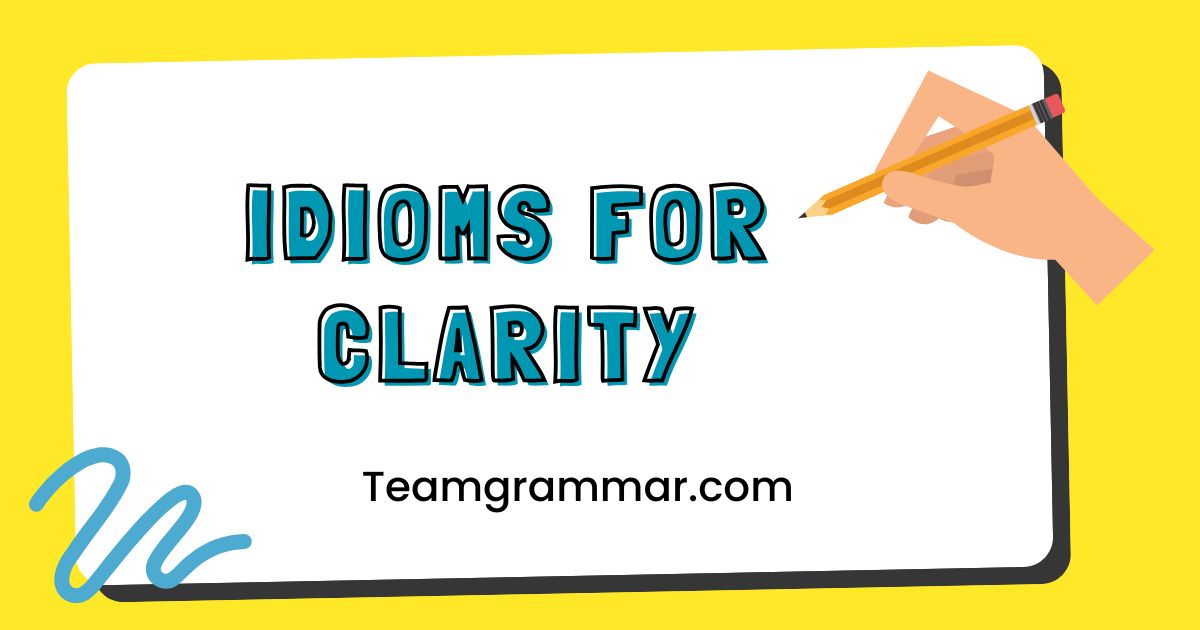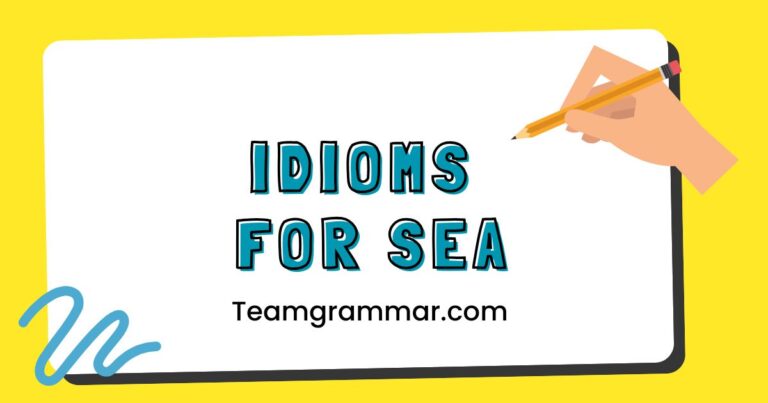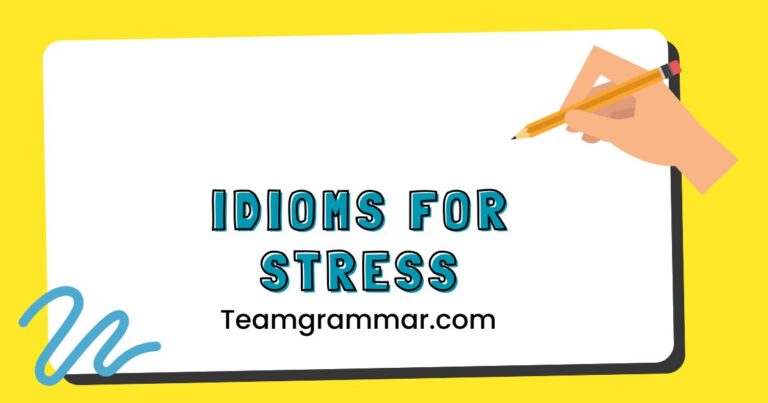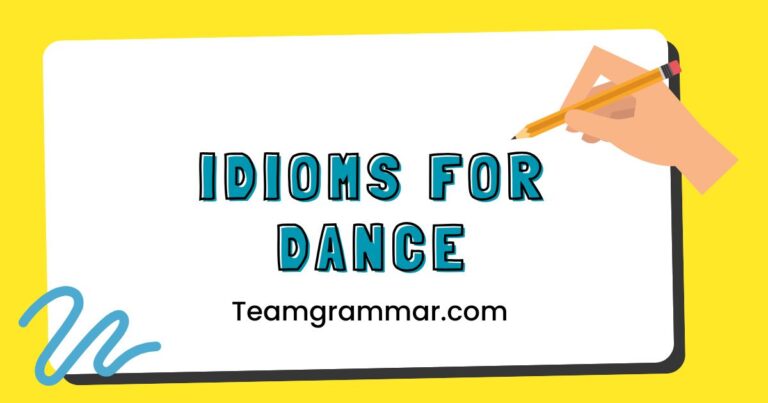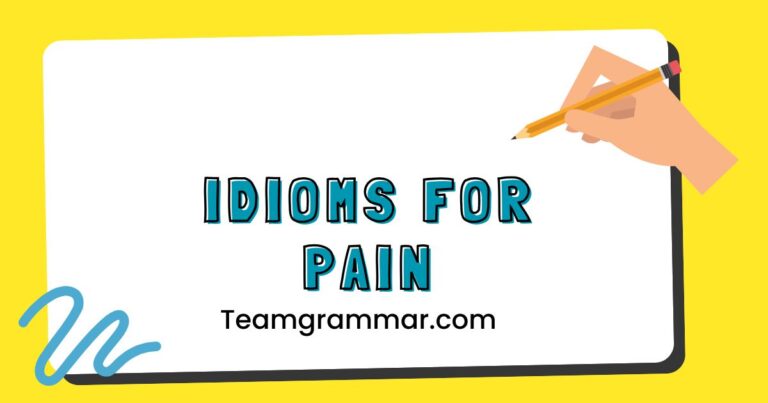35 Idioms for Clarity: Mastering Figurative Language in English
Understanding idioms is crucial for mastering English, as they add color and nuance to everyday communication. Idioms are phrases whose meanings cannot be understood from the literal definitions of the individual words.
This article focuses on idioms related to ‘clear’ or ‘clarity,’ helping learners grasp their meanings and use them effectively. This knowledge is beneficial for ESL students, advanced learners, and anyone looking to enhance their English fluency and comprehension. By exploring these idioms, you’ll gain a deeper understanding of the English language and culture, improving both your spoken and written communication skills.
Table of Contents
- Introduction
- Definition of Idioms for Clarity
- Structural Breakdown
- Types and Categories
- Examples of Idioms for Clarity
- Usage Rules
- Common Mistakes
- Practice Exercises
- Advanced Topics
- FAQ
- Conclusion
Introduction
Idioms are an integral part of the English language, adding depth and color to communication. They are expressions whose meanings differ from the literal interpretations of the individual words.
Mastering idioms is essential for achieving fluency and understanding native speakers. This article focuses specifically on idioms related to the concept of ‘clear’ or ‘clarity,’ equipping you with the knowledge to use them effectively.
By understanding these idioms, you can enhance your comprehension, improve your speaking skills, and gain a deeper appreciation for the nuances of the English language. This skill is beneficial for both native speakers and English language learners.
Idioms related to clarity can express different aspects, such as ease of understanding, lack of ambiguity, or the act of making something understandable. These phrases often rely on figurative language, such as metaphors and similes, to convey their meanings.
Understanding the context in which these idioms are used is crucial for interpreting them correctly. This article provides a comprehensive guide to these idioms, including examples, usage rules, and practice exercises, to help you master this challenging but rewarding aspect of English grammar.
Definition of Idioms for Clarity
An idiom is a phrase or expression whose meaning cannot be understood from the ordinary meanings of its individual words. It’s a figurative expression where the collective meaning is different from the literal meaning.
Idioms related to “clarity” are those that describe the state of being easily understood, free from ambiguity, or the process of making something understandable. These idioms often use metaphorical language to convey abstract concepts related to understanding and perception.
The function of these idioms is to add color and expressiveness to language, often making it more vivid and engaging.
The classification of idioms for clarity can be broad, covering expressions that describe various aspects of understanding, such as intelligibility, transparency, and lucidity. The context in which these idioms are used is crucial for determining their intended meaning.
For example, an idiom like “clear as a bell” describes something that is easily heard or understood, while “muddy the waters” refers to making something confusing or unclear. Understanding the underlying metaphor or analogy is key to grasping the meaning of these idioms.
Idioms are often culturally specific, reflecting the values and experiences of the language community.
Structural Breakdown
The structure of idioms varies widely. Some idioms are simple phrases, such as “crystal clear,” while others are more complex clauses or sentences.
The grammatical structure of an idiom doesn’t necessarily reflect its meaning. For instance, the idiom “clear the air” is a verb phrase, but its meaning relates to resolving conflict or misunderstanding.
The components of an idiom often function together as a single unit of meaning, and they cannot be easily separated or modified without altering the idiom’s meaning or grammatical correctness. The power of idioms lies in their fixed structure and widely understood figurative meaning.
Many idioms for clarity contain nouns, verbs, adjectives, and adverbs, all working together to create a figurative meaning. For example, in the idiom “in plain English,” the adjective “plain” modifies the noun “English” to convey the idea of language that is simple and easy to understand.
The preposition “in” further specifies the context in which this language is used. Analyzing the individual components of an idiom can sometimes provide clues to its meaning, but it’s essential to understand the idiom as a whole unit.
The meaning of an idiom resides in its overall effect and cultural understanding, rather than the sum of its parts.
Types and Categories
Transparent Idioms
Transparent idioms are those whose meanings can be easily inferred from the literal meanings of the individual words. While they are still considered idioms because their meaning is not entirely literal, they are relatively easy to understand.
For example, “clear as day” is a transparent idiom because the idea of daylight being easily visible helps to understand the meaning of something being obvious or easily understood. These idioms are often used to emphasize a point or to make a statement more vivid.
Transparent idioms are an excellent starting point for learners of English as they provide a bridge between literal and figurative language.
Opaque Idioms
Opaque idioms are those whose meanings are difficult or impossible to infer from the literal meanings of the individual words. These idioms often have historical or cultural origins that are not immediately apparent.
For example, the idiom “clear as mud” is an opaque idiom because the idea of mud being clear is contradictory, and the idiom’s meaning (unclear or confusing) is not obvious from the individual words. Opaque idioms require a deeper understanding of the English language and culture to be fully grasped.
Mastering opaque idioms is a sign of advanced language proficiency.
Metaphorical Idioms
Metaphorical idioms use a metaphor to convey their meaning. A metaphor is a figure of speech that compares two unlike things without using “like” or “as.” Many idioms for clarity rely on metaphors to express abstract concepts related to understanding.
For example, the idiom “shed light on” uses the metaphor of light illuminating a dark area to convey the idea of making something clearer or more understandable. Metaphorical idioms can be particularly effective in making language more vivid and engaging.
Recognizing the underlying metaphor is key to understanding the meaning of these idioms.
Examples of Idioms for Clarity
This section provides a comprehensive list of idioms related to clarity, categorized by their specific meanings. Each idiom is accompanied by a definition and example sentences to illustrate its usage.
Understanding these idioms will significantly enhance your ability to communicate effectively in English. The examples are designed to cover a wide range of contexts and situations, ensuring that you are well-prepared to use these idioms in your own speech and writing.
Mastering these idioms will add depth and sophistication to your language skills.
General Clarity
These idioms describe situations where something is generally understandable or easy to perceive.
| Idiom | Definition | Example Sentence |
|---|---|---|
| Clear as a bell | Very clear and easy to understand. | Her instructions were as clear as a bell, so everyone knew what to do. |
| Clear as day | Obvious or easily understood. | It’s as clear as day that he’s in love with her. |
| Crystal clear | Extremely clear; unambiguous. | The company’s policy on overtime is crystal clear. |
| Plain as the nose on your face | Very obvious or easy to see. | The solution to the problem was as plain as the nose on your face. |
| In plain English | In simple, straightforward language. | Can you explain that in plain English, please? |
| See the light | To understand something after a period of confusion. | After hours of debate, he finally saw the light and agreed with our proposal. |
| Come to light | To become known or revealed. | New evidence has come to light in the investigation. |
| As clear as mud | Not clear at all; confusing. | The instructions were as clear as mud, and nobody could understand them. |
| In black and white | In writing; explicitly stated. | We need to get the agreement in black and white before we proceed. |
| Paint a picture | To describe something in detail. | The speaker painted a vivid picture of the future. |
| Get the picture | Understand the situation. | “Are you following me?” “Yes, I get the picture.” |
| Perfectly clear | Completely understandable. | The reasons for his resignation were perfectly clear. |
| Shine a light on | To make something clearer or more visible. | This report shines a light on the issues facing the community. |
| In broad daylight | Openly and visibly. | The robbery occurred in broad daylight. |
| Make head or tail of something | To understand something. | I can’t make head or tail of these instructions. |
| Get something off your chest | To talk about something that has been bothering you. | I need to get something off my chest – I’m not happy with the project. |
| Lay bare | To reveal or expose something. | The investigation laid bare the corruption within the company. |
| Bring to the fore | To bring something to attention. | The crisis brought to the fore the need for better planning. |
| Spell out | To explain something in detail. | I had to spell out the instructions for him several times. |
| Figure out | To understand or solve something. | I’m trying to figure out how to solve this problem. |
| Straighten out | To clarify or resolve a misunderstanding. | We need to straighten out this issue before moving forward. |
| See through | To understand the true nature of something or someone. | I can see through his lies. |
| Read between the lines | To understand the hidden meaning. | You have to read between the lines to understand what she really means. |
| Connect the dots | To understand how different pieces of information relate to each other. | Once I connected the dots, I understood the whole plan. |
| Piece together | To assemble or understand something from different parts. | We had to piece together the story from various sources. |
Easily Understood
These idioms specifically highlight the ease with which something can be understood.
| Idiom | Definition | Example Sentence |
|---|---|---|
| A piece of cake | Very easy to do. | The exam was a piece of cake. |
| Easy as pie | Very easy. | Learning to ride a bike is as easy as pie for most kids. |
| No-brainer | Something that requires little or no thought. | Accepting the job offer was a no-brainer. |
| Watered down | Made less forceful or intense. | The report was watered down to avoid controversy. |
| Dumbed down | Simplified to the point of being insulting. | The explanation was dumbed down for the audience. |
| At a glance | Immediately; with a quick look. | I could tell at a glance that something was wrong. |
| On the surface | Appearing to be true or obvious. | On the surface, the problem seems simple. |
| Elementary, my dear Watson | Obvious (often used humorously). | The solution is elementary, my dear Watson. |
| In a nutshell | In a few words; concisely. | In a nutshell, the project was a success. |
| Briefly stated | Said in a short and clear way. | Briefly stated, the issue is a lack of funding. |
| Point taken | I understand your point. | Point taken; I will revise my approach. |
| Understood | Clearly grasped or comprehended. | The instructions were clearly understood by all participants. |
| Click with someone | To understand and get along with someone immediately. | I clicked with her as soon as we met. |
| Take on board | To understand and accept advice or criticism. | I will take your comments on board and make the necessary changes. |
| Get the drift | To understand the general idea. | I get the drift of what you’re saying. |
Lack of Clarity
These idioms describe situations where something is not clear or is confusing.
| Idiom | Definition | Example Sentence |
|---|---|---|
| Muddy the waters | To make something unclear or confusing. | His explanation only muddied the waters further. |
| Foggy | Unclear or vague. | The details of the agreement are still foggy. |
| Hazy | Unclear or uncertain. | My memories of that day are hazy. |
| In the dark | Uninformed; unaware. | They kept me in the dark about their plans. |
| Up in the air | Uncertain; undecided. | Our travel plans are still up in the air. |
| Clouded | Obscured or unclear. | His judgment was clouded by emotion. |
| Lost in translation | Meaning is not conveyed accurately. | Some of the humor was lost in translation. |
| Beats me | I don’t know. | “Where did she go?” “Beats me!” |
| Double Dutch | Incomprehensible language. | What they were saying was Double Dutch to me. |
| Greek to me | Incomprehensible. | The instructions were Greek to me. |
| All Greek | Impossible to understand. | This legal document is all Greek to me. |
| Mumbo jumbo | Nonsense. | That report is just a lot of mumbo jumbo. |
| Not have a clue | To have no understanding. | I don’t have a clue what he’s talking about. |
| None the wiser | Not understanding anything more than before. | After the explanation, I was none the wiser. |
| Obscure | Not clear or easily understood. | The meaning of the poem is obscure. |
Making Clear
These idioms describe the act of clarifying or making something understandable.
| Idiom | Definition | Example Sentence |
|---|---|---|
| Clear the air | To resolve a conflict or misunderstanding. | We need to clear the air after that argument. |
| Shed light on | To make something clearer or more understandable. | The investigation shed light on the corruption within the organization. |
| Bring to light | To reveal or make known. | The documents brought to light new evidence. |
| Draw a picture | To explain something in detail. | Let me draw a picture for you of how this works. |
| Get to the bottom of | To discover the truth about something. | We need to get to the bottom of this issue. |
| Lay it on the line | To state something clearly and directly. | I had to lay it on the line and tell him the truth. |
| Put one’s cards on the table | To be honest and open about one’s intentions. | I decided to put my cards on the table and tell her how I felt. |
| Come clean | To confess or admit something. | He decided to come clean about his mistakes. |
| Get something straight | To clarify something. | Let’s get something straight – I won’t tolerate that behavior. |
| Set the record straight | To correct a false or inaccurate account. | I want to set the record straight about what happened. |
| Straight from the horse’s mouth | From a reliable source. | I heard it straight from the horse’s mouth. |
| Get down to brass tacks | To focus on the essential facts. | Let’s get down to brass tacks and discuss the budget. |
| Make sense of | To understand. | I’m trying to make sense of this situation. |
| Get the message | To understand what is implied. | I think he finally got the message that we don’t want him here. |
| Decode | To convert into understandable language. | I’m trying to decode what he meant with that statement. |
Truth and Clarity
These idioms relate to truth becoming clear and evident.
| Idiom | Definition | Example Sentence |
|---|---|---|
| The truth will out | The truth will eventually become known. | Don’t worry, the truth will out in the end. |
| See the truth | Understand the real facts. | After reviewing the evidence, he finally saw the truth. |
| Face the truth | Accept the reality, even if it’s unpleasant. | It’s time to face the truth about our financial situation. |
| The scales fall from one’s eyes | Suddenly understand something that was previously hidden. | The scales fell from my eyes when I realized what he was doing. |
| Come to terms with | Accept something difficult or unpleasant. | She’s trying to come to terms with her loss. |
Usage Rules
Idioms must be used in the correct context to be effective. Using an idiom inappropriately can lead to confusion or miscommunication.
Pay attention to the tone and register of the situation. Some idioms are informal and best suited for casual conversations, while others are more formal and appropriate for professional settings.
Ensure that the idiom fits the overall style of your communication.
The grammatical structure of an idiom is fixed, and it should not be altered. Changing the word order or substituting words can destroy the idiom’s meaning and make it nonsensical.
For example, instead of saying “clear as a bell,” saying “clear like a bell” changes the expression and reduces its impact. Some idioms have specific grammatical requirements, such as the use of certain prepositions or verb tenses.
Pay close attention to these details to ensure that you are using the idiom correctly. The best way to master the usage rules of idioms is through practice and exposure to authentic English language materials.
Reading books, watching movies, and listening to native speakers will help you develop an intuitive understanding of how idioms are used in context.
Common Mistakes
One common mistake is taking idioms literally. Because idioms have figurative meanings, interpreting them literally can lead to misunderstandings.
For example, if someone says “it’s raining cats and dogs,” they don’t literally mean that animals are falling from the sky. Instead, they mean that it’s raining very heavily.
Another common mistake is altering the wording of an idiom. Idioms are fixed expressions, and changing the words can make them meaningless.
For example, instead of saying “clear as a bell,” saying “clear like a bell” changes the expression and reduces its impact.
Another frequent error is using idioms in inappropriate contexts. Some idioms are informal and best suited for casual conversations, while others are more formal and appropriate for professional settings.
Using an informal idiom in a formal situation can sound unprofessional or disrespectful. Similarly, using a formal idiom in a casual conversation can sound stilted or unnatural.
It’s essential to be aware of the tone and register of the situation and choose idioms accordingly. Understanding the cultural context of idioms is also crucial.
Some idioms are specific to certain regions or cultures, and using them in a different context can be confusing or even offensive. It’s important to be aware of these cultural nuances and to use idioms appropriately.
Here are some examples:
| Incorrect | Correct | Explanation |
|---|---|---|
| The instructions were clear like a bell. | The instructions were clear as a bell. | The correct idiom is “clear as a bell,” not “clear like a bell.” |
| He kept me on the dark about his plans. | He kept me in the dark about his plans. | The correct idiom is “in the dark,” not “on the dark.” |
| She decided to put her cards on the table. | She decided to lay her cards on the table. | While “put her cards on the table” is acceptable, “lay her cards on the table” is more common. |
| The truth will out eventually. | The truth will be out eventually. | The correct idiom is “the truth will out” |
Practice Exercises
These exercises will help you practice using idioms for clarity in different contexts. Choose the correct idiom to complete each sentence.
The answers are provided below.
| Question | Answer |
|---|---|
| 1. The company’s new policy is __________, so everyone understands it. | Crystal clear |
| 2. After the argument, they needed to __________. | Clear the air |
| 3. The solution to the problem was __________. | Plain as the nose on your face |
| 4. The details of the agreement are still __________. | Foggy |
| 5. The exam was __________. | A piece of cake |
| 6. The investigation __________ the corruption. | Shed light on |
| 7. He decided to __________ and confess. | Come clean |
| 8. Our travel plans are still __________. | Up in the air |
| 9. I can’t __________ of these instructions. | Make head or tail |
| 10. The truth will __________. | Out |
| 11. He had to __________ and tell her the truth. | Lay it on the line |
| 12. The instructions were __________ to me. | Greek |
| 13. After reviewing the evidence, he finally __________ . | Saw the truth |
| 14. We need to __________ this issue before moving forward. | Straighten out |
| 15. I heard it __________ . | Straight from the horse’s mouth |
Advanced Topics
For advanced learners, exploring the etymology and historical context of idioms can provide a deeper understanding of their meanings and usage. Many idioms have fascinating origins that reflect the cultural and historical experiences of English speakers.
Researching the origins of idioms can reveal insights into the values, beliefs, and customs of the past. This knowledge can enhance your appreciation for the richness and complexity of the English language.
Understanding the historical context of idioms can also help you use them more effectively in your own communication.
Another advanced topic is the use of idioms in literature and rhetoric. Authors and speakers often use idioms to add color, emphasis, and emotional impact to their language.
Analyzing how idioms are used in literary works can provide valuable insights into the author’s style and message. Similarly, studying the use of idioms in persuasive speeches and arguments can help you develop your own rhetorical skills.
Paying attention to the context in which idioms are used and the effect they have on the audience can enhance your ability to communicate effectively and persuasively. Exploring the use of idioms in different genres and media can also broaden your understanding of their versatility and impact.
FAQ
- What is an idiom?
An idiom is a phrase or expression whose meaning cannot be understood from the ordinary meanings of its individual words. It’s a figurative expression where the collective meaning is different from the literal meaning.
- Why is it important to learn idioms?
Learning idioms is essential for achieving fluency in English and understanding native speakers. Idioms add color and expressiveness to language, and they are frequently used in everyday communication.
- How can I learn idioms effectively?
The best way to learn idioms is through practice and exposure to authentic English language materials. Reading books, watching movies, listening to native speakers, and using flashcards can all be helpful.
- Are idioms the same in all English-speaking countries?
No, idioms can vary between different English-speaking countries and regions. Some idioms are specific to certain cultures or dialects.
- Can I create my own idioms?
While you can create new phrases, they won’t be considered idioms unless they are widely adopted and understood by native speakers. Idioms are established expressions with a history of usage.
- What should I do if I don’t understand an idiom?
If you don’t understand an idiom, ask for clarification or look it up in a dictionary or online resource. Pay attention to the context in which the idiom is used to help you understand its meaning.
- Is it okay to use idioms in formal writing?
It depends on the idiom and the context of the writing. Some idioms are appropriate for formal writing, while others are too informal. Use your judgment and consider your audience.
- How can I avoid using idioms incorrectly?
Pay attention to the usage rules of idioms and practice using them in different contexts. Be aware of the tone and register of the situation and choose idioms accordingly. If you’re unsure about an idiom’s meaning or usage, it’s best to avoid using it.
- Are there resources that can help me learn idioms?
Yes, there are many online dictionaries, books, and apps dedicated to idioms. These resources often provide definitions, examples, and quizzes to help you learn and practice using idioms.
- How do I know when to use an idiom?
Idioms should be used when they fit naturally into the conversation or writing and when you are comfortable that your audience will understand them. Consider the formality of the setting and the potential for misunderstanding.
Conclusion
Mastering idioms related to clarity is a valuable skill for anyone looking to improve their English language proficiency. These idioms add color, nuance, and expressiveness to communication, allowing you to convey your ideas more effectively.
By understanding the meanings and usage rules of these idioms, you can enhance your comprehension, improve your speaking skills, and gain a deeper appreciation for the richness and complexity of the English language. Continuous practice is key to integrating these idioms into your active vocabulary.
Remember to pay attention to the context in which idioms are used, and be aware of the potential for misinterpretation. Don’t be afraid to ask for clarification or look up an idiom if you’re unsure of its meaning.
With consistent effort and dedication, you can master these idioms and significantly enhance your ability to communicate clearly and effectively in English. Embracing the challenge of learning idioms will not only improve your language skills but also broaden your cultural understanding and appreciation for the English language.

